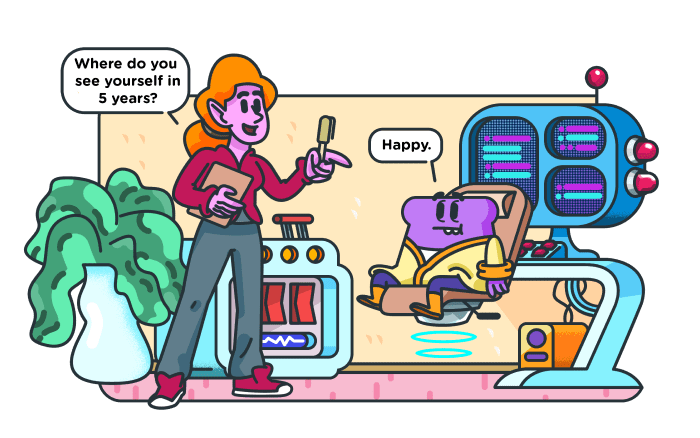The differences between long-term and short-term planning
Last updated on: October 26, 2022
Sometimes, planning is easy – you know exactly where you want to go for lunch and your plan for the future is crystal clear.
But more often than not, planning is difficult – from lack of resources to lack of vision, from not knowing where and how to start to having difficulties with setting effective goals. The future can be unpredictable and planning can be tricky.
Yet, it’s not impossible. In this article, we’ll go over what long-term and short-term planning mean, what is the difference, as well as how to successfully do both. Of course, with examples included.

Table of Contents
What are long-term and short-term planning?
Let’s start by defining what long-term and short-term planning are.
What is short-term planning?
Short-term planning is usually considered to take 12 months or less. Your daily, weekly, monthly, even quarterly and yearly goals – all can be filed under “short-term goals.” They are stepping stones that will help you to reach your big goal(s).
That type of planning requires you to look at the current situation and fix potential issues as soon as possible. Sometimes “as soon as possible” takes a day, sometimes 6 months, depending on the complexity of the issue.
Here are some examples of short-term goals, divided into five categories: career, education, personal development, finances, and marketing.
- Career goals: “Apply for a job”, “Make a website for your business.”
- Academic goals: “Take another marketing course”, “Pass the AP Statistics exam.”
- Personal development goals: “Start going to bed before midnight”, “Track your time for a month”, “Join a gym.”
- Financial goals: “Pay off the debt”, “Get a raise before the end of the year.”
- Marketing goals: “Increase brand awareness”, “Boost website traffic.”
💡 If you need help with setting short-term goals, these articles can come to the rescue: How to plan your day and stay organized & How to make productivity plan in five easy steps. For easier planning, check out Online planner templates too.
What is long-term planning?
Long-term planning involves goals that take a longer time to reach and require more steps; they usually take a minimum of a year or two to complete. They aim to permanently resolve issues and reach and maintain success over a continued period.
We’ll discuss an exact strategy to set and complete long-term goals later in this article.
Before that, let’s go over a few examples of long-term goals:
- Career goals: “Build a profitable business”, “Turn your passion into a career.”
- Academic goals: “Get a Bachelor’s degree”, “Get a Master’s degree abroad.”
- Personal development goals: “Learn a foreign language”, “Travel on all 7 continents.”
- Financial goals: “Save for retirement”, “Become a millionaire.”
What is medium-term planning?
That’s not all, folks: there’s also medium-term planning. It entails applying more permanent solutions to short-term problems and implementing policies and procedures to make sure that those short-term problems won’t happen again. If a piece of equipment breaks, a short-term solution would be to fix it, while a medium-term solution would be to invest in a service contract.
Another example of medium-term planning is investing in employees’ training programs rather than organizing a workshop from time to time (which is a short-term solution).
Key differences between long-term and short-term planning
The most obvious difference between long-term and short-term planning is the amount of time each one takes; while short-term planning involves processes that take 12 months or less, long-term planning is, as the name suggests, longer – there’s no upper limit to the longevity of a long-term plan.
There’s an anecdote that Ingvar Kamprad, founder of IKEA, told a group of managers that it’s “important to think where we should be in 200 years.” (You don’t have to think that far ahead – a 5-year plan is completely fine.)
Another difference is their complexity: long-term planning is more elaborate, tactical, and involves more steps. As opposed to that, short-term planning is often quite straightforward. Short-term goals usually serve as milestones that get you to your long-term goal.
In business, short-term goals are mostly focused on internal issues, such as customer complaints or inefficient management, while long-term goals cover both external and internal issues. When you’re planning long-term, you need to be aware of external factors, like global trends and changes, political situation, the ways current events may affect the economy, and so on.
The difference between long-term and strategic planning
Another frequently asked question is: Is strategic planning the same as long-term planning? If not, what’s the difference between the two?
Strategic planning consists of statements and goals that determine things such as:
- Where your company should be in the next couple of years and how to get there;
- How to successfully respond to changes in the environment;
- What’s the anticipated financial performance;
- What’s the most effective business strategy.
Strategic plans are not actionable – that’s where long-term planning comes in.
Long-term planning determines concrete processes and actions needed to achieve strategic goals. It also focuses on setting priorities, aligning resources, forecasting, and handling unexpected changes.
In other words, strategic planning determines what and long-term planning determines how.
How to set long-term goals in 5 steps
As setting good long-term goals is the foundation of every other planning you’re going to do, it’s important to get it right. That can often be hard and overwhelming, especially if you’re making plans for the distant future, e.g. 10 years in advance – which is why we made this step-by-step guide.
Step 1: Define your vision
Ask yourself: What is your (or your company’s) vision? What is your purpose? What are your core values? If you’re a company: what problem do you want to solve and how would the world look without that problem?
Ideally, where would you want to be 3, 5, and 10 years from now? What is, right now, stopping you from achieving that? What changes do you need to make? If (or better to say, when) you manage to achieve your goals, how different would things be, and in what way?
All these questions will help you clarify what do you want to achieve. The next step is – how to get there?
Step 2: Set SMART goals
If you’re sure in the direction you want to take, it’s time to set goals. They should be challenging, yet achievable, and most importantly, they should be SMART.
The examples I’ll provide to explain each letter of this acronym are mostly short-term goals as it’s easier to understand that way, but these criteria can (and should) be applied to any type of goal, including long-term goals.
- Specific: Once I heard someone say that “goals should have their name and last name”, meaning they need to be as particular and well-defined as possible. “I want to find a job” is not a specific goal, while “I want to land a _____ position in ____ field, preferably in ____ type of company in ____ area” has a name, last name, even a middle name.
- Measurable: In order to know if you’re making progress, you need to be able to measure it. That’s why setting goals such as “increase brand awareness” is not very good – how do you know if you accomplished it or not? Instead, try something like “get 5K followers on Instagram and 1K likes on our Facebook page.”
- Attainable: As we mentioned above, the goals you set should be challenging, but possible to achieve. “Earn a million dollars in a week” is measurable and time-bound, but not realistic, at least not for most of us (that being said, if it’s realistic for you, go ahead and set that goal).
- Relevant: Relevant goal is a goal that fits your vision and has importance to you. If you want to be a lawyer, setting a goal of graduating from medical school doesn’t make a lot of sense for your career path.
- Time-bound: Give yourself a specific time frame to complete the goal; if it has multiple steps, impose a deadline for each milestone.
Step 3: Break down your goals into smaller ones
After you set your SMART goals, it’s time to break them down into smaller chunks, that will again be divided into series of actionable steps.
Big goals often consist of a few milestones that you need to reach; each one should become its own short-term or medium-term goal. Think of them as checkpoints in a race or levels in a game – you need to pass them all to get to the finish line and win.
Keep dividing it until your big goal becomes a weekly or daily to-do list. The more complicated the goal is, the more times you’ll have to break it down into smaller parts.
Let’s say you just got into university and your goal is to get your Bachelor’s degree.
- First, you’ll divide it into 3 or 4 goals (depending on how many years it lasts): “finish 1st year”, “finish 2nd year”, and so on.
- To be able to do that, you need to pass your exams, and each of the exams will become its own goal.
- To pass each exam, you usually have to take quizzes, write papers, make presentations, etc; again, each of those pre-requirements becomes a subgoal.
- Then you divide that into concrete steps: doing research, writing the first draft of your paper, editing it…
By making tiny steps like these, you’ll eventually and gradually accomplish your long-term goal.
Step 4: Prioritize
Go through your list of goals and put them in the order of their priority. That will facilitate making short-term goals and organizing your time, energy, and money in the right way. First focus on the goal(s) that will make the most difference and that align with your values the most.
Also, ask yourself: Are there some areas that need immediate assistance? Are any of those goals time-sensitive? What is the likely outcome of (not) making this a priority?
Step 5: Keep updating your list
Goals and priorities may change over time. Because of that, it would be a good idea to occasionally go through your list, make sure it’s up to date and change something if needed.
Conclusion
There are different types of planning: short-term, long-term, and medium-term. Short-term planning focuses on resolving present issues and takes 12 months or less.
Long-term planning is more complex and tactical and takes more time.
Medium-term planning means applying long-term solutions to short-term problems.
What all of them have in common is that all of them require thinking ahead, setting goals effectively, and problem-solving.
✉️ Do you find long-term and short-term planning difficult? What are your long-term and short-term goals? What is, according to you, the best way to plan for the future? Write to us at blogfeedback@clockify.me for a chance to be featured in future articles.





